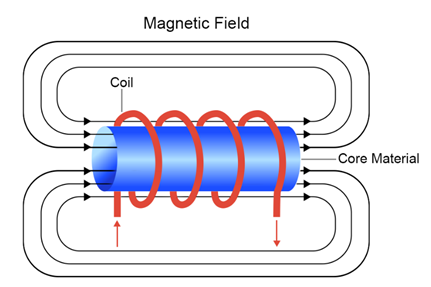How Induction Heating works
Induction heating is a method in which a material capable of conducting electricity is heated by being exposed to a moving magnetic field, without direct contact with the heating element. This process is both uncomplicated and cost-effective, providing rapid and consistent heating compared to traditional methods used for tasks like preheating and relieving stress in welds. The heat is generated by causing an electric current to circulate within the material as it interacts with the magnetic field—a phenomenon known as electromagnetic induction.
To achieve effective heating, the material should have low resistance (as seen in metals), and a high voltage must be applied. For instance, metals with high resistance like iron will heat up more quickly than metals with low resistance like copper. Heat is produced through the dissipation of energy caused by resistance and hysteresis losses as the induced electric current flows through the material. Hysteresis losses are particularly prominent in ferromagnetic materials when they undergo magnetisation and demagnetisation.

Induction heating finds significant usage in industrial processes where manufacturers seek to alter the physical properties of metals, such as bonding, hardening, and softening. This method offers the advantage of being environmentally friendly, as it doesn’t involve combustion emissions, and it maintains a controlled and steady rate of heat transfer with minimal loss. In contrast to conventional heating methods like flame or resistance heating, induction heating is straightforward to set up, achieves the desired temperature quickly, is safer, and boasts higher efficiency, accuracy, and uniformity.
The Operation of Induction Heating: In the preceding section, we explored the concept of induction heating; now, let’s delve into how this process actually operates. When an electric current flows through a copper conductor, it generates a magnetic field encircling the conductor. The direction of this magnetic field depends on the direction of the electric current, following the right-hand thumb rule.
The intensity of the magnetic field corresponds to the amount of current passing through the conductor—the stronger the current, the larger and more powerful the magnetic field. Reversing the direction of the electric current also results in a change in the magnetic field. Passing an alternating magnetic field through a conductive material induces localized electric currents within the metal. These currents are referred to as eddy currents, and their magnitude increases with the strength of the magnetic field.
Metals possess a certain degree of electrical resistance, causing the eddy currents to circulate against the resistance of the metal, resulting in its heating. This phenomenon is known as Joule heating and accounts for the majority of the generated heat.
The electrical resistance of the conductive material undergoing heating significantly influences the amount of heat produced. For example, materials with low resistance demand a greater generation of eddy currents for heating, compared to those with higher resistance. Additionally, when heating ferrous materials, it’s important to consider hysteresis losses—these arise due to the material’s resistance to changes in a magnetic field. Although hysteresis losses generate less heat than Joule heating, they still contribute significantly to the overall heat within the material.
Furthermore, the magnetic characteristics of the conductive material being heated have a substantial impact on the heat generation. Magnetic materials like iron produce more heat due to hysteresis losses, whereas non-magnetic materials like copper or aluminum exhibit no hysteresis-related heat generation.
Eddy currents generate heat primarily at the surface of the part adjacent to the heating coil. The depth of heating is determined by the speed at which the alternating magnetic field oscillates within the material. The remaining thickness of the part is heated through conduction from the heated portion.
